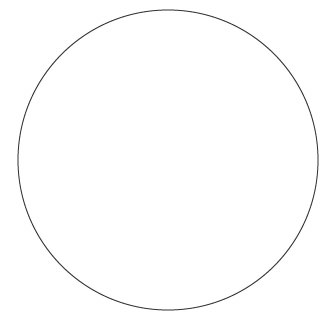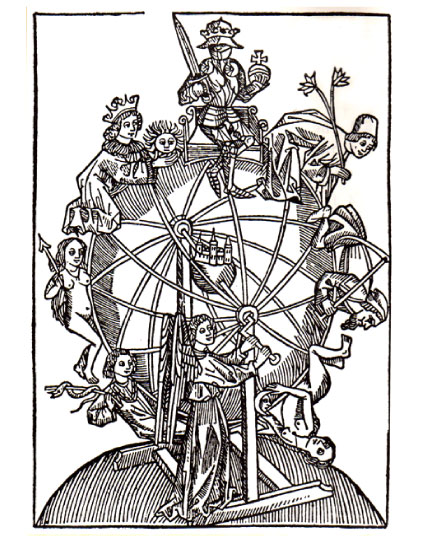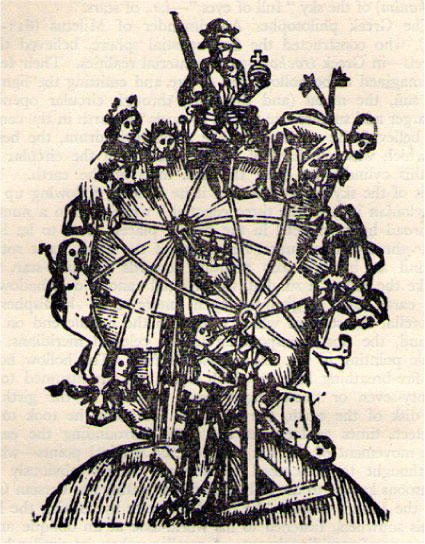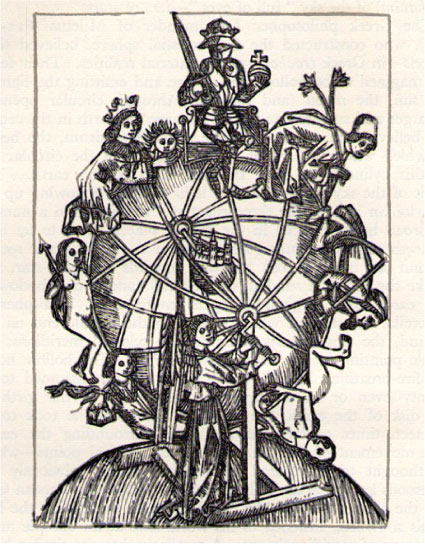The Wheel of Fortune was a common sight in the Middle Ages. It was depicted on the walls of churches and versions of it can be found in countless manuscripts. Its popularity was a byproduct of the immense popularity of
The Consolation of Philosophy, the 6th century work of Boethius. It was written, so they say, while he awaited execution. In chapter 2 of H.R. James 1897 translation, available at
Project Gutenberg, Fortune says, "This is my art, this the game I never cease to play. I turn the wheel that spins. I delight to see the high come down and the low ascend." The chapter is remarkably brief — excepting the short poem which accompanies it, it consists of a single paragraph. It leaves a great deal to the imagination. A description of the blind workings of Fate in an age that was supremely unfair obviously touched a nerve.

Today, the Wheel of Fortune seems primarily connected to a lowbrow television program, more popular, I imagine, even on a per capita basis, than
The Consolation of Philosophy. But, it is also known, thanks to the New Age Movement and, to a lesser extent, T.S. Eliot, as a Tarot card. Besides that, it persists as an actual gambling game. At carnivals, we are invited to
Spin the wheel and win a prize. Roulette is obviously based on it. While it may seem odd that something on the walls of churches is also closely connected with gambling and fortunetelling, we should remember that the wheel and its association with Fate greatly precedes Christianity. The Dharma Wheel, the well-known symbol of Buddhism, is one example, Neolithic stone circles are undoubtedly another.
I scanned this reduced copy of the Wheel from Michael Dummett's beautiful book
The Visconti-Sforza Tarot Cards, George Braziller, Inc. (New York, 1986). The original card is in the Pierpont Morgan Library. The deck of 72 cards was hand painted with gilt backgrounds in about 1450. Obviously, this graphic does not do it justice.
Of this card, Gertrude Moakley, in
The Tarot Cards Painted by Bonifacio Bembo, New York Public Library (1966) said,
Fortune is shown here in her most common form, with the revolving wheel and four human figures. According to a medieval epigram, the one on the way up is growing a pair of ass ears, and is saying "Regnabo" (I shall reign). The one on top has full-grown ass ears, holds the rod of a ruler, and is saying "Regno" (I reign). The figure on the way down has lost his ears, but acquired a tail. He is saying "Regnavi" (I reigned). The lowliest of the group, the man at the bottom, is the only fully human figure of the four. His words are "Sum sine regno" (I am without reign). Fortune herself has a pair of golden wings, and that expression of blissful unawareness of which Dante writes in his description of her:
But she is blissful and she does not hear;
She, with the other primal creatures, gay
Tastes her own blessedness, and turns her sphere.
Dummet, who tends toward the literal, adds:
The figures on the left and at the top have asses' ears, to show the folly of human ambition, and that on the right has a tail, perhaps to show his degradation. This led, in the Tarot de Marseille, to their replacement by various beasts. This was purely a carmaker's misunderstanding of the symbolism: the figures are all human.
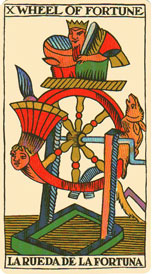
To assume that the symbolism in the Marseille deck is the result of error, since he fails to understand it, seems a bit unimaginative. This rather odd example of the Marseille card is from the so-called Spanish Tarot, a deck based on a 1736 Italian version of a French original, or perhaps itself only a copy. It was produced by Heraclio Fournier of Vitoria, España. [A Christmas present from Amie a few years ago.] It should give some indication of what Dummett meant.
It is difficult to see the ears in the Visconti-Sforza card — they are worked into the card itself rather than painted — but perhaps you can make out one ear rising from the figure in profile on the left. The ears of the reigning king are much easier to see. The speech scrolls (called
banderoles ) are also worked into the card. They contain, as already mentioned,
Regnabo,
Regno,
Regnavi, and
Sum sine regno. Even in Dummett's wonderful copy they are difficult to read.
Moakley does not say which medieval epigram is responsible for the asses' ears, and for good reason. It is much more probable that they are based on Greek Mythology. Paul Huston, in
The Devil's Picturebook, G.P. Putnams' Sons (1971) credits them to the story of Midas and the musical contest between Apollo and Pan. It ties in nicely with the symbolism I will discuss further on. Midas awarded the victory to Pan, whose music was obviously inferior. Apollo was so incensed by this that he gave Midas asses' ears. Midas, of course, is the king who acquires the golden touch, much to his regret. Pan and Apollo are symbolic opposites. Apollo represents the light of the sun and, therefore, the vertical, the spiritual, the possibility of enlightenment. Pan represents the horizontal, the material, the great ex PAN se of the physical world. So, his golden touch with its disastrous consequences together with his decision to support Pan over Appolo represents, symbolically, a turning away from the eternal spiritual to embrace the mundane material. Of course, there are many other ways to express this. In
The Myths of Greece & Rome: Their Stories, Signification and Origin, George G. Harrap & Company (London, 1912) H.A. Guerber quotes Swift as saying,
The god of wit, to show his grudge
Clapt asses' ears upon the judge;
A goodly pair, erect and wide,
Which he could neither gild nor hide.
[This book was a present from my employer twenty-some years ago.] But, there is no mention of a tail. Nor does the figure on the bottom have ears or tail.
As for the ears, I do not doubt their association with Greek Mythology — it seems rather obvious once you've been made aware of it — but I do think something more obvious is also at work. The ears protrude from the head, and from the ass end protrudes a tail. Coins are also symbols of Fate and Fortune. Like the wheel, they happen to be round. They also alternate.
Heads I win,
tails you lose. The painter worked a wealth of associations into this card. The coin required a tail. One association need not exclude another.
Disregarding Fortune, there are four figures associated with the Wheel. There are three in the Marseille card. In fact, there are endless variations on the Wheel involving the number of spokes, the number of people or animals, whether Fortune is present or not, whether the Wheel has a crank or not. Modern esoteric versions of the card present even more variables. Russian icons proceed from a strict canon. Much of the variation from one to the next has more to do with skill of execution than with choice of content. There is no canon associated with the Wheel of Fortune, there is only the brief reference in Boethius. Each artist is more or less on his own. What is difficult for those infected by Modern Art to understand is that each artist was on his own to present a range of symbols in the most economical, the most efficient way he could. Each artist told the same story large or small.
The Visconti-Sforza card is quite remarkable. It hints at a great many stories. The two figures on either side, except for the ears and tail, are almost identical. One faces up, the other down. They are in profile. The figure on top is seated on a throne and faces us directly. The figure on the bottom, dressed in white, advanced in age, faces ahead, but toward the ground. In fact, he does not cling to the wheel at all. If we consider this card carefully, we see that he actually supports the wheel. Of course, this could just be coincidence. It could be a way of emphasizing that he is on all fours — old men and babies are weak of limb. The old man without a reign is about to say,
Regnabo. But there is more. The old man is dressed in white as if ready for burial. He looks toward his resting place.
If we translate this discussion into a larger context, the four seasons of the year, for example, the figure on top represents fruition and summer, the king on his thrown, and the figure opposite him, the one who has no reign, represents death and winter. His sepulcheral robe suggests a cold blanket of snow. Which leaves spring and fall, the equinoxes, the two points in the annual cycle where day and night are equal. These are pivot points in the year. Another way of imagining this is to place your fingers lightly on either side of a coin and with your thumb cause it carefully to spin — heads, tails, heads, tails. Summer alternates with winter by means of the horizontal axis of spring and fall. Notice that the figure on the left is in green — the color of springtime. The figure on the right is dressed in red — the color of dying leaves.
In an earlier post,
Hain * 6867, Fortuna turns the Wheel of the Planets — intermediaries of Fate. Here she turns the Wheel of the Seasons, the great Wheel of the Year. There are four seasons and eight spokes, six of them visible. There are three living seasons and one that is death. It can also be divided into thirds, as it seems to be in the Marseille card — more clearly elsewhere. Or in half — light/dark, up/down, before/after. With or without ears. In fact, the year of twelve months does all these things at once.
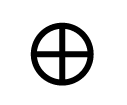
The life of one man is like the life of the earth. In an even earlier post,
What On Earth, I demonstrated how from the symbol for Earth, a circle with a cross, the symbols for the planets are derived. Jesus, who dies on the cross, has this to say about death. "Verily, verily, I say unto you, Except a corn of wheat fall into the ground and die, it abideth alone: but if it die, it bringeth forth much fruit." [King James Version] Death is the basis of the system. If we hoard grains of wheat, as Midas hoarded material wealth, eventually we have nothing. Next He says, "He that loveth his life shall lose it; and he that hateth his life in this world shall keep it unto life eternal." Die to the world as the corn of wheat dies and we have everything. At least the wheel continues to turn.
The second incarnation of Vishnu, following Matsya, the Fish, is Kurma, the Turtle. With his back he supports the great wheel of the earth. By now, that should be a familiar image. He dove into the depths of the ocean to give support, to raise the earth from the churning ocean. One of the divisions of the Wheel is water below, heaven or air above. It is the basis for baptism.
These stories weren't thrown together for Sunday School. They have been with us since the dawn of time. They are everywhere and in everything. They exist in the spectacle of the heavens, in the great motions of the earth, inside each and every one of us. Even on pasteboard playing cards.
